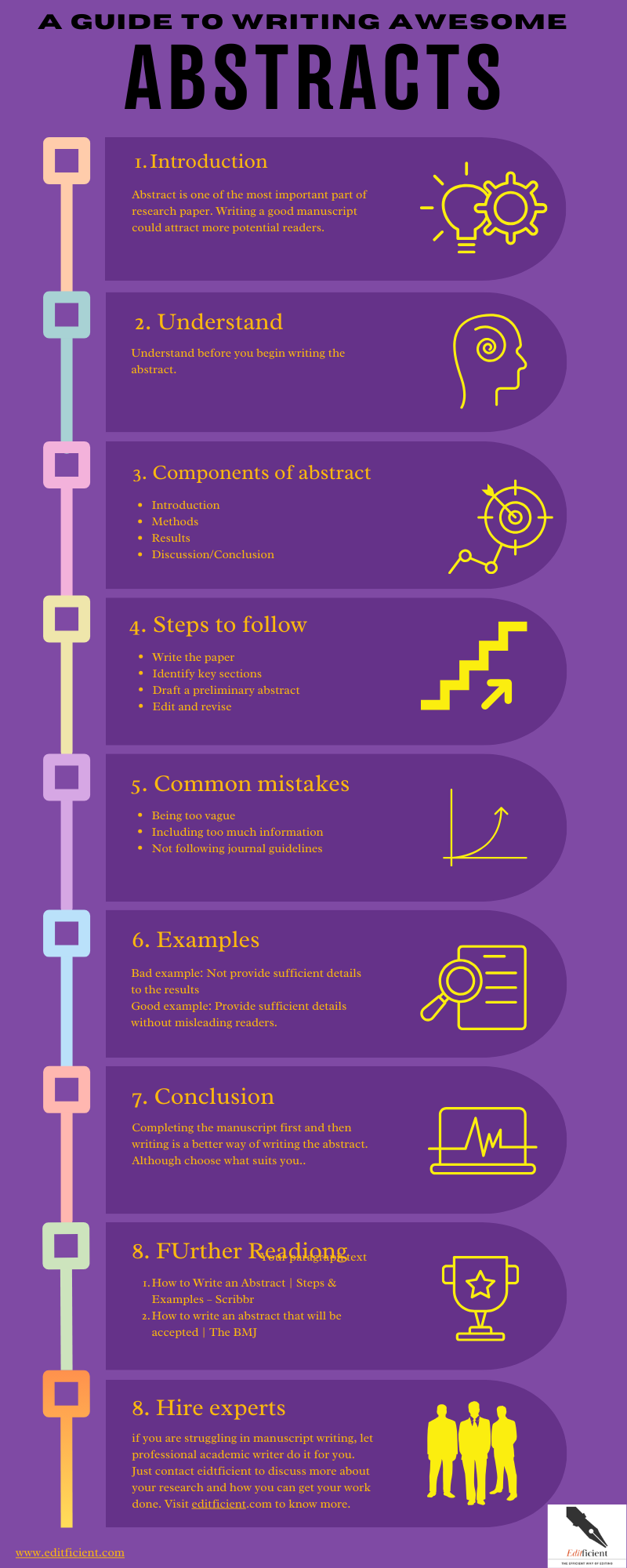
1. Introduction
An abstract is a vital component of academic research, acting as a window into your work. It’s a brief yet powerful summary of your research paper, thesis, or in-depth analysis. A compelling abstract can significantly enhance the visibility and impact of your research, making it an essential skill for every researcher. This blog aims to guide you through the process of the processes involved in crafting one such for your paper. We have discussed its types, key components, writing steps, common mistakes, and providing examples.
1.1. What an abstract
An abstract is a concise summary of a research paper, review, or book chapter. It provides a snapshot of the work, encapsulating the purpose, methodology, findings, and conclusions in a brief overview. Journals often require an abstract. Just like keywords, an abstract also allows readers to quickly ascertain the paper’s relevance to their interests. It serves as a ‘trailer’ for the full paper, helping readers decide whether to read the full text. The word limit for an abstract typically ranges from 150 to 250 words, although this can vary depending on the journal or conference.
Read our other blogs: Alzheimer’s Disease Cure: Is this the cure we were waiting for?

1.2. Importance of a well-written abstract
A well-written abstract is crucial for several reasons. Firstly, it’s often the first (and sometimes only) part of your paper that people read. Therefore, it needs to be clear, concise, and compelling to attract readers’ attention and encourage them to read the full paper. Secondly, a well-written abstract can help your paper be found in database searches, increasing its visibility and impact. The components of a well-written abstract include a clear statement of the research problem or objective. A description of the methods used, a summary of the results, and a statement of the conclusions drawn forms the abstract. A well-written abstract can significantly enhance the reach and impact of your research.
Read our other blogs: How to create effective diagrams, illustrations, or figures for review publications
2. Understanding Different Types of Abstracts
Abstracts can be categorized into three main types: Descriptive, Informative, and Highlight. Each type has a unique purpose and structure, and the choice of type depends on the nature of your research and the requirements of the journal or conference.
2.1. Descriptive Abstracts
Descriptive abstracts provide a brief overview of the main topics covered in the research without going into much detail about the results or conclusions. They typically include information about the purpose of the research, the methodology used, and the scope of the study. Descriptive abstracts are often shorter than other types of abstracts, usually not exceeding 100 words. They are commonly used in social sciences and humanities, where the research is often more qualitative and interpretive.
2.2. Informative Abstracts
Informative abstracts are the most common type of abstract and are used across a wide range of disciplines. They provide a concise summary of the entire research paper, including the purpose of the research, the methodology used, the main results, and the conclusions. Informative abstracts allow readers to quickly understand the key findings and implications of the research without having to read the entire paper. They are typically between 150 and 250 words long, although this can vary depending on the journal or conference.
2.3. Highlight Abstracts
Highlight abstracts, also known as structured abstracts, are a newer type of abstract that is becoming increasingly popular in scientific research. They are typically used in medical and clinical research and are structured into predefined sections such as Background, Methods, Results, and Conclusions. Highlight abstracts allow readers to quickly locate specific information and make it easier to compare the findings of different studies. They are usually between 200 and 300 words long.
Read our other blogs: How to create effective diagrams, illustrations, or figures for review publications
3. Key Components of an Effective Abstract
An effective abstract is structured around four key components: Introduction/Purpose, Methods, Results, and Discussion/Conclusion. Each component plays a crucial role in conveying the essence of your research.
3.1. Introduction/Purpose
The introduction or purpose component sets the context for your research. It should clearly state the research problem or objective and its significance. This section answers the question, “Why did you do this study or project?” It’s important to articulate the purpose of your research in a way that piques the reader’s interest and gives them a reason to continue reading.
3.2. Methods
The methods component describes how you conducted your research. It should provide enough information for the reader to understand your approach but doesn’t need to include every detail. This section answers the question, “What did you do and how?” It’s crucial to strike a balance between being concise and providing enough information for the reader to understand your methodology.
3.3 Results
The results component presents the main findings of your research. It should be clear and concise, focusing on the most important results. This section answers the question, “What did you find?” It’s important to present your results in a way that is understandable to your target audience.
3.4. Discussion/Conclusion
The discussion or conclusion component interprets the results and explains their implications. It should tie back to the research problem or objective stated in the introduction and indicate whether the research met its objectives. This section answers the question, “What do your findings mean?” It’s crucial to end your abstract on a strong note, summarizing the significance of your research and its potential impact.
Read our other blogs: Why Publishers Reject Book Chapters and How to Prevent It?
4. Step-by-Step Guide to Writing an Abstract
Writing an abstract can seem daunting, especially if you’re doing it for the first time. However, by breaking it down into manageable steps, the process becomes much more straightforward. Here’s a step-by-step guide to help you craft a compelling abstract:
4.1. Step 1: Write the paper first
Before you can write a comprehensive abstract, you need to complete your research paper. The abstract is a summary of your work, so it’s essential to have a clear understanding of your paper’s content. Writing the paper first allows you to identify the key points that need to be included in the abstract.
4.2. Step 2: Identify key sections
Once your paper is complete, identify the key sections that will form the basis of your abstract. These typically include the introduction or purpose, methods, results, and discussion or conclusion. Highlight the most important points from each section to include in your abstract.
4.3. Step 3: Draft a preliminary abstract
With your key points identified, you can now draft a preliminary abstract. Start with a clear statement of the purpose of your research. Then, briefly describe your methods and summarize your main results. Finally, discuss the implications of your findings. Remember to keep your language clear and concise.
4.4. Step 4: Edit and revise
After drafting your abstract, take the time to revise and edit. Check for clarity, coherence, and conciseness. Make sure your abstract accurately reflects the content of your paper and doesn’t contain any information not included in the paper. Also, ensure that it meets the word limit and formatting requirements of the journal or conference.
5. Common Mistakes to Avoid When Writing an Abstract
Writing an abstract is a skill that requires practice and precision. However, even experienced researchers can sometimes make mistakes. Here are some common pitfalls to avoid when writing an abstract:
5.1. Being too vague
An abstract should be clear and specific. Avoid using vague language or jargon that might confuse the reader. Instead, use precise terms that accurately convey your research’s purpose, methods, results, and conclusions. Remember, your abstract is often the first (and sometimes only) part of your paper that people read, so clarity is crucial.
5.2. Including too much (or too little) information
Striking the right balance of information in your abstract is essential. Including too much information can make your abstract lengthy and overwhelming, while too little information can leave the reader confused about your research’s purpose and findings. Aim to provide a concise yet comprehensive overview of your research, focusing on the most important points.
5.3. Not following guidelines
Each journal or conference has specific guidelines for abstracts, including word limit, formatting, and structure. Not adhering to these guidelines can lead to your paper being rejected before it’s even read. Therefore, always check the guidelines and ensure your abstract complies with them.
Read our other blogs: ChatGPT Vs. Human Writing | Why journals do not want to publish ChatGPT-written articles papers?
6. Examples of Good vs. Bad Abstracts
Understanding the difference between a good and a bad abstract can be instrumental in improving your abstract writing skills. Let’s analyze what makes an abstract effective and compare examples of good and bad abstracts.
6.1. Analysis of what makes an abstract effective
An effective abstract is clear, concise, and comprehensive. It provides a snapshot of the research, including the purpose, methods, results, and conclusions. It’s written in a way that is understandable to the intended audience and accurately represents the content of the paper. An effective abstract also adheres to the word limit and formatting guidelines provided by the journal or conference.
6.2. Comparison of good and bad examples
6.2.1. Bad Abstract Example
“This paper discusses the effects of a new drug on blood pressure. The results were significant.”
Analysis: This abstract is too vague. It doesn’t provide enough information about the purpose of the research, the methods used, or the specific results. It also doesn’t discuss the implications of the findings.
6.2.2. Good Abstract Example
This randomized controlled trial investigated the effects of Drug X on systolic and diastolic blood pressure in 50 adult patients with primary hypertension. Patients were administered Drug X or a placebo for 12 weeks. Drug X significantly reduced both systolic (p<0.01) and diastolic (p<0.05) blood pressure compared to the placebo. These findings suggest that Drug X may be an effective treatment for primary hypertension.”
6.2.3. Analysis
This abstract is clear and comprehensive. It provides specific information about the purpose of the research, the methods used, the main results, and the conclusions. It also adheres to the typical structure of an abstract, making it easy for readers to understand.
7. Conclusion
Mastering the art of abstract writing is a valuable skill for any researcher. A well-crafted abstract not only enhances the visibility and impact of your research but also serves as a testament to your understanding and presentation of your work. This guide has provided you with insights into the different types of abstracts, the key components of an effective abstract, a step-by-step guide to writing an abstract, and common mistakes to avoid. As we conclude, we encourage you to apply these tips and techniques in your next abstract writing endeavor. Remember, like any other skill, abstract writing improves with practice. So, keep refining your abstract until it accurately and compellingly represents your research. Good luck!
Read our other blogs: Enhancing Your Research Manuscript with Graphs and Figures: A Visual Approach to Communicating Findings
8. Reading
Below are some articles which provide comprehensive guides on how to write effective abstracts, including step-by-step instructions, tips, and examples. They cover various aspects of abstract writing, such as the structure of an abstract, common mistakes to avoid, and how to make your abstract stand out.
- How to Write an Abstract | Steps & Examples – Scribbr
- How to write an abstract that will be accepted | The BMJ
- 10 Good Abstract Examples That Will Kickstart Your Brain – Kibin
- Your essential ‘how-to’ guide to writing good abstracts – LSE Blogs
- 15 Abstract Examples: A Comprehensive Guide – Paperdue.com
- How to Write an Abstract: 4 Tips for Writing an Abstract – MasterClass
- Writing an Abstract for Your Research Paper – The Writing Center – University of Wisconsin-Madison
- Writing an Abstract – University of Melbourne
- Writing Report Abstracts – Purdue Online Writing Lab
- How to Write a Scientific Abstract – Wiley
Read our other blogs: Keywords in Research Articles: A Brilliant Guide for PhD Students with 4 Amazing Examples
9. Take the help of expert professional writers
Writing a research paper or a review isn’t an easy task, especially when it comes to crafting a compelling abstract. This is where expert professional writing services like Editficient come into play. With a team of skilled writers who specialize in academic writing, Editficient can significantly enhance the quality of your manuscript.
The writers at Editficient understand the nuances of abstract writing and are adept at summarizing complex research in a clear and concise manner. We are familiar with the structure and components of an effective abstract and can help researchers avoid common mistakes that could undermine the impact of your research.
Our writers are experienced in various academic disciplines, ensuring that your abstract is not only well-written but also accurate and relevant to your field of study. We can help you highlight the significance of your research, making your abstract more compelling to readers and also preparing a readily acceptable manuscript in a high impact factor peer reviewer journal. So, why not give Editficient a try for your next manuscript writing endeavor?
Read our other blogs: Common challenges faced by non-native English speakers with manuscripts
10. Key Takeaways
Want to save this guide? Download the poster and take it with you.

